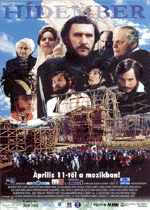
| Laura Hollósi | Two people, one film |

|
Géza Bereményi: Bridgeman
 62 KByte |
After several years of wrangling, Géza Bereményi's latest film, Bridgeman was finally completed. After the premier probably all those were convinced of the goodwill of the makers, who earlier did not even want to hear about the film, since papers had written about it so many things in the past years, but only very few people actually declared (for example, Miklós Fáy of Élet és Irodalom) that after all a Hungarian film was being made, which might as well be good. So, it is worth paying attention to the film, since the point is that there is a new Hungarian film directed by Géza Bereményi about Count István Széchenyi. Géza Bereményi One is Bereményi's essays appeared in Filmvilág at the beginning of the 1980es in which he wrote that although nobody pays enough attention to script writers apart from the profession itself, they still leave their fingerprints on the films they contributed to. That time Bereményi - besides writing literature and lyrics for Tamás Cseh - was writing scripts to directors, such as András Kovács, Ferenc András or Péter Gothár. Bereményi's world is so typical indeed that his fingerprints can at once be recognised: in it a man's life is at the same time independent and not of the society and politics around him. Let us just think of the performers of Veri az ördög a feleségét, who are either from the country or the city, the young generation in Megáll az idő or the mid-generation of A nagy generáció drowned in self-deception. What is obvious in Bereményi' scripts is the quasi-impartiality he portrays his "heroes" with; we cannot take sides regarding who supports who, whether anyone can be right or we can speak about "heroes" at all. We might mention the subtly (self)-ironic gesture with which Bereményi "signed" his name in the films mentioned above, since the director's original name is not Bereményi, but Vetró and he gave this name to the Budapest director of Veri az ördög a feleségét, as well as to the inventor locked in an asylum of A nagy generáció. So, Bereményi was right in the article mentioned earlier: there are scriptwriters indeed, whose presence in the completed film is strong enough to grow out of the frames. It is not by surprise that in 1985 he received the opportunity to shoot a film of one of his scripts. Tanítványok was later followed by internationally acclaimed Eldorado (1988). Then new films were shot (Turné, 1993), but Bereményi remained faithful to his "original" profession, since in the past few years he has written scripts to films such as Meteo and Potyautasok. These movies carry on the already well known Bereményi visions, that is, given are the individual and the world he needs to live and love in, but the question is whether it is possible at all to exist here. Bridgeman's Count Széchenyi belongs to these figures as well. Count István Széchenyi Who decides to read Széchenyi's Diary, will immediately see that these are the thoughts of a man of extraordinary qualities. Reading diaries and memoirs is mainly exciting because we can "peep into" other people's treasured secrets, but we are eager to find points of identification between the writer and ourselves. Although before he died, Széchenyi had told his secretary to delete all the parts from the diary that might be too compromising or too personal (which he obediently did), yet we learn quite a lot from the Diary about Széchenyi, the individual. It is rather surprising, for instance, that in his diary he devotes only a few sentenced to the significant event, when he offered his annual income for the establishment of the Hungarian Academy of Sciences. We also learn that Széchenyi had enormous psychological sense, since he was "analysing" people around him and himself as well all the time. The notes he made about "poor Crescence" are also worthy of interest, since according to him, the woman often walked around the house in gown for days without bothering to comb her hair (which today we would call depression). But it also turned out about him that he could not pass a problem without thinking about its solution for days. He was also the first to promote the regular bath in Hungary. These are only a few examples picked from the notes of the "greatest Hungarian" and first of all we remember him as the builder of Chain Bridge or the man who promoted creating the Hungarian middle class. One thing is for sure: he was striving to do good. In a rather surprising note he writes that one night he was praying to God to find out whether he decided to be a politician out of selfishness or because he wanted to contribute to the improvement of his country. After analysing himself deeply, he drew the conclusion that he was not driven by selfishness. And we, the readers, do believe him, since he proved this through his actions. The film Making a film of a person's life is a great challenge, even if the individual did not carry out such large-scale activities as Széchenyi, which forced Bereményi and his co-writer Can Togay to make at least ten versions of the script. In this case the point was to create a precise and tight fitted script, since when working with a huge crew and a crowd of extras on a film, the book can be the only crutch (here what helped was that Bereményi probably already had ideas in mind regarding each scene). Owing to the fact that Bereményi as a script writer does not despise the American traditions, he managed to compile the most significant events of Széchenyi's life to get a historically authentic (although the historians will decide in this question; otherwise in works of art there is no point in demanding "historical authenticity" at all), understandable and tightly composed film. The writer-director did not get lost in the details and limited the number of performers and events as well. The movie starts with the scene where Count Széchenyi (played by Károly Eperjes) is taken to the Döbling asylum. The count, who calls himself the Antichrist, hit the lowest point in his life then, during the 1848 freedom fight. This is followed by his life history told in chronological order: we can see the baby as he is being christened (religion and God played a significant part in his life), then the little boy is taught by the highly educated father to respect the emperor, and appreciate the serfs and the nation. Although the young Széchenyi enjoyed the company of women and idle lifestyle, after the death of his seduced sister-in-law, Caroline, he grew more serious and from then on he was encouraging the birth of the Hungarian middle class within the boundaries of the Monarchy. His father's death and his hopeless love for Crescence (wife of Count Zichy) further stimulated him to do something useful and his friendship with Baron Wesselényi of Transylvania even deepened his Hungarian identity. His friendship later broke up due to different political views, but when the Habsburg court expelled Wesselényi after a show trial, and sent him to prison, Széchenyi decided to support him. Of course, the film deals with the political relationship between Széchenyi and Kossuth, presenting Kossuth as an eager young man. The freedom movement itself is hardly mentioned in the movie, since Széchenyi did not agree with the idea of the revolution. Then we see the executions, the news about which further deepened his neurosis. Now the film returns to the "present", when the count regained clear conscious after spending years lonely and in ill-health. In secret he starts to have writings published which protest against the Bach-era. The Monarchy obviously did not welcome this activity: historians still have not been able to prove that Széchenyi really committed suicide or was perhaps killed, but the fact is that his death was favourable for those afraid of his writings. Bereményi found the solution to avoid taking a stand in the question of murder/suicide: the shot went off behind closed doors, so we cannot be sure who pulled the trigger, the count himself or the hired assassin of the Monarchy. Of course, Bereményi makes Széchenyi the absolute main character of the film, so it might as well be a film of the "count's personal development". As regards the genre, however, it is a historical and biographic movie. In Hungarian film history Zoltán Várkonyi directed similar genre films, but these were characterised by storytelling mainly, since he did not consider film or image solutions significant at all. This is what Bereményi's films aim to fulfil. The director did not only strive to present Széchenyi's life relying on historical facts and being faithful to the period, but also took special care of using not only typical film solutions for the above mentioned genres (1). The film is about the man and his time, but the viewers do not get a simple historical movie. Bereményi achieves this by handling time layers in an interesting way and editing two and three events together (here we must praise editor Teri Losonci). Let us just consider the solution of editing the hunting scene with the heated argument between Caroline and Széchenyi, then later Széchenyi's suicide attempt with Caroline's death scene. And we could continue the list longer. Bereményi makes use of the mass scenes: the cameras are in constant motion, approaching the crowd usually from above (the photographer is Sándor Kardos), finally settling on one of the main characters (especially in the parliament scenes). The character differences between Széchenyi and Kossuth are best shown by the camera movements: Kossuth is almost always in motion, while Széchenyi was photographed from fixed settings (see: the theatre scene). Of course, it also changes, depending on the count's mood. Part of the scenes with Crescence is also "active", let just recollect their dance in the ball or when Széchenyi confesses his love to her in the carriage. Széchenyi's craziness is also displayed by very strong visual solutions, for example, in the scene when Széchenyi lies on the ground in the asylum with pieces of newspaper in his mouth. At the same time the film is highly poetic, since the idea of constructing the bridge is composed within the count when looking out of the window at Crescence's window, where the beloved woman is standing, which shows that they also need an "emotional bridge" between them (2). Crescence - Széchenyi's greatest and most important muse - is present in every scene where the count makes a major decision. Forming the main character was rather a challenging task for Károly Eperjes, since he had to portray an extremely complex figure. The figure of the young and light-headed count was depicted by the actor's well-known gestures (slanting mouth), but parallel with the intellectual maturity of the count, Eperjes' gestures become subtler and he is able to portray the serious and philosophical man. Although Adél Kováts, playing Széchenyi's greatest love, Caroline, only appears in a few early scenes, the actress is capable of showing the passionate yet sickly faithful woman, whose death changed the count completely. Caroline's self-destructive nature is manifested in behavioural patterns that were not "acceptable" by the contemporary society: she makes scenes, openly expresses her love for Széchenyi, rides the horse too fast and kisses her lover in front of her husband. Caroline's naturalistically filmed death (blood flowing from her mouth, then the dead woman lying in the dark room) reminds us of Emile Zola. Széchenyi's new love, Crescence (played by Irina Latchina), however, brought the figure of the "pure woman" (although Crescence was a married woman with quite a few child births behind her), with whom Széchenyi only had Platonic relation (which even the husband, Count Zichy "approved of"). After Zichy's death, Széchenyi could finally marry his loved one who gave him two sons (and a daughter who died). Prior to their marriage, the scenes between them might as well have been melodramatic, but Bereményi tried to counterpoint them by changing the focus of the camera (the opera house scene) or showing the overwhelming emotional outbursts with frequent cuts (the already mentioned carriage scene and the ball scene). György Cserhalmi, portraying Wesselényi, takes the role ironically, so the viewer has the impression that perhaps he plays the parody of his former roles, since we have already seen him so often as an ultra-Hungarian or a macho. Iván Darvas, as Metternich, is extremely convincing, he does his job with cold manners, trying to hold back Hungarian aristocracy. The other characters are also excellent, including Ervin Nagy (Kossuth), Marius Bodochi (Clam), László Sinkó (Zichy) and Can Togay (Batthyányi). Bereményi managed to get the best performances from his actors and actresses. Nevertheless, we feel sorry that this time he and photographer Sándor Kardos did not have the chance to experiment as they did in the earlier, low-budget movies. It is true, though, that there are quite a few wonderful and interesting solutions, for example, the use of the camera in scenes where the Austrian soldiers march across the Chain Bridge, or Széchenyi's death and the shipping on the Danube, where the camera photographs the soldiers from below. At the same time owing to digital effects, the two creators could free their minds and use their imagination. For instance, there is a scene where we can see contemporary Pest with the Chain Bridge under construction and at last there is a well-edited "action scene" in a Hungarian film: the last element of Chain Bridge is being pulled up, Széchenyi is watching it from a boat below, but the chain is torn and he almost gets killed. Bereményi is poetic here, since he shows Széchenyi's floating between life and death by filming Caroline under, while Crescence above water. Of course, it would be difficult to deal with the question whether this film has deficiencies or not, and what they are. Such a large-scale film has never been made in Hungary, so we could compare it only with Western-European or American blockbusters. But what is more important to remark is that by shooting Bridgeman, Bereményi did not deny himself, since he deprived Széchenyi's figure of all the stuck-on labels, and managed to depict him not as a hero, but as a human being. Széchenyi perhaps differs from Bereményi's earlier "heroes" in that he was not understood by the era, while the previous ones could not understand the world itself. We hope that Bereményi's new film will be interpreted as an excellent movie made of a great, but fallible (Hungarian) man by a talented (Hungarian) film director. Notes
Translated by Adrea Danyi
|  82 KByte
|  74 KByte
|  80 KByte
|  70 KByte
|  72 KByte
|  80 KByte
|  81 KByte
|  70 KByte |